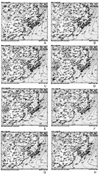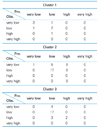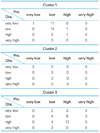1. Lewis WH, Vinay P, Zenger VE. Airborne and allergenic pollen of North America. 1983. Baltimore & London: The Johns Hopkins University Press.
2. Esch RE, Bush RK. Adkinson NF, Yunginger JW, Busse WW, Bochner BS, Holgate ST, Simons FER, editors. Aerobiology of outdoor allergens. Middleton's allergy princiles and practice. 2003. 6th ed. St. Louis: Mosby;529–555.

3. Taylor G, Walker J, Backley CH. 1820-1900: A detailed description of the astonishing achievement of Backley in describing the causes of hay fever. Clin Allergy. 1973. 3:103–108.
4. Lewis W, Imber W. Allergy epidemiology in the St. Louis, Missouri Area II, grasses. Ann Allergy. 1975. 35:42–50.
5. Anderson JH. Allergenic airborne pollen and spores in Anchorage, Alaska. Ann Allerg. 1985. 54:390–399.
6. Potter PC, Cadman A. Pollen allergy in South Africa. Clin Exp Allergy. 1996. 26:1347–1354.

7. Esch RE, Bush RK. Adkinson NF, Yunginger JW, Busse WW, Bochner BS, Holgate ST, Simons FER, editors. Aerobiology of outdoor allergens. Middleton's allergy princiles and practice. 2003. 6th ed. St. Louis: Mosby;529–555.

8. Solomon WR, Weber RW, Dolen WK. Bierman CW, Pearlman DS, Shapiro GG, Busse WW, editors. Common allergenic pollen and fungi. Allergy, asthma and immunology from infancy to adulthood. 1996. 3rd ed. Philadelphia: WB Saunders;93–114.
9. Oh JW. Characteristics and distribution of airborne pollen and mold. J Pediatr Allergy Respir Dis. 1998. 8:1–15.
10. Oh JW, Lee HL, Kim JS, Lee KI, Kang IJ, Kim SW, Lee HB. Aerobiological study of pollen and mold in the 10 states of Korea. Pediatr Allergy Respir Dis (Korea). 2000. 10:22–33.
11. Oh JW, Pyun BY, Choung JT, Ahn KM, Kim CH, Song SW, Son JA, Lee SY, Lee SI. Epidemiological change of atopic dermatitis and food allergy in school-aged children in Korea between 1995 and 2000. J Korean Med Sci. 2004. 19:716–723.

12. Vázquez LM, Galán C, Domínguez-Vilches E. Influence of meteorological parameters on olea pollen concentrations in Cordoba (South-Western Spain). Int J Biometeorol. 2003. 48:83–90.
13. Emberlin J, Savage M, Jones S. Annual variations in grass pollen seasons in London 1961-1990: trends and forecast models. Clinic Exp Allergy. 1993. 23:911–918.

14. Frenguelli G, Bricchi E. The use of phenoclimatic model for forecasting the pollination of some arboreal taxa,. Aero-biologia. 1998. 14:39–44.

15. Galán C, Cari-anos P, García-Mozo H, Alcázar P, Domínguez-Vilches E. A model for forecasting Olea europaea L. airborne pollen in the South-West Andalucia, Spain. Int J Biometeorol. 2001. 45:59–63.

16. Garchia-Mozo H, Galán C, Gomez-Casero MT, Domínguez-Vilches E. A comparative study of different temperature accumulation methods for predicting the start of the Quercus pollen season in Córdoba (South West Spain). Grana. 2000. 39:194–199.

17. Smith M, Emberlin J. A 30-day-ahead forecast model for grass pollen in north London, United Kingdom. Int J Biometeorol. 2006. 50:233–242.

18. Beggs PJ. Impacts of climate change on aeroallergens: past and future. Clin Exp Allergy. 2004. 34:1507–1513.

19. Ziska LH, Gebhard DE, Frenz DA, Faulkner S, Singer BD, Straka JG. Cities as harbingers of climate change: common ragweed, urbanization, and public health. J Allergy Clin Immunol. 2003. 111:290–295.

20. Wayne P, Foster S, Conolly J, Bazzaz , Epstein P. Production of allergenic pollen by ragweed (Ambrosia artemisiifolia L.) is increased in CO
2-enriched atmospheres. Ann Allergy Asthma Immunol. 2002. 88:279–282.

















 PDF
PDF ePub
ePub Citation
Citation Print
Print

















 XML Download
XML Download